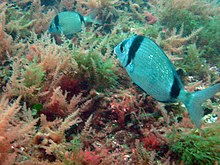Asparagopsis armata
Appearance
| Asparagopsis armata | |
|---|---|

| |
| (Diplodus vulgaris). In the background, Asparagopsis armata | |
| Scientific classification | |
| Clade: | Archaeplastida |
| Division: | Rhodophyta |
| Class: | Florideophyceae |
| Order: | Bonnemaisoniales |
| Family: | Bonnemaisoniaceae |
| Genus: | Asparagopsis |
| Species: | A. armata
|
| Binomial name | |
| Asparagopsis armata | |
| Synonyms | |
|
Falkenbergia rufolanosa | |
Asparagopsis armata is a marine red algae species. It was first described in 1855 by Harvey, who found the algae on the Western Australian coast.[1] Native to the Southern hemisphere, it has been introduced to the Northeastern Atlantic Ocean and the Mediterranean Sea.
Its life cycle has two distinct phases:[1]
- the gametophyte phase occurs in Europe between June and September. It is pale purple-red, and it has 1 mm wide and up to 200 mm long irregularly branched thalli. The lower branchlets have characteristic harpoon-like barbs.
- the tetrasporophyte phase (previously identified as Falkenbergia rufolanosa) occurs in Europe all year round. It is brownish red, branched and filamentous and grows in 15 mm diameter tufts.
References
- Ní Chualáin, F.; Maggs, C.A.; Saunders, G.W. & Guiry, M.D. (2004). "The invasive genus Asparagopsis (Bonnemaisoniaceae, Rhodophyta): molecular systematics, morphology, and ecophysiology of Falkenbergia isolates". Journal of Phycology. 40 (6): 1112–1126. doi:10.1111/j.1529-8817.2004.03135.x.
